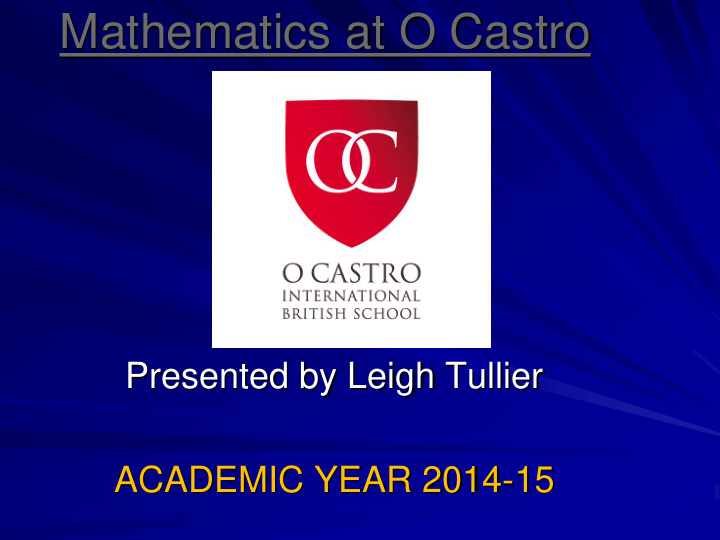



Mathematics at O Castro Presented by Leigh Tullier ACADEMIC YEAR 2014-15
Presentation contents Introduction, rationale and aims Creativity in maths Vocabulary in maths Mental maths strategies (KS1/2) Written maths strategies (KS2) Calculations in context Further information
Rationale “Do you know anyone who feels neutral about maths? We suspect not. Indeed, we would go as far as to suggest that the majority of people either love it or hate it.” (Cockburn and Littler 2008, p.3)
Aims: We want children to leave with a bank of mathematical skills, the confidence to use and apply them in everyday situations, the ability to take risks and enjoy challenges. Maths is everywhere!
Creative opportunities to learn Maths .
Pattern The ability to spot pattern underpins all of mathematics. Growing patterns Repeating patterns 1, 1, 2, 3, 5, 8, 13 …?
Resources Resources are essential to help representation and develop visual imagery.
Vocabulary Mathematical Where do you see symbols this word in everyday (if any) life? What other Describe what your mathematical word or phrase Subtraction words is it means. related to? Use your word or Picture or diagram Phrase in a statement.
I already know It can’t be… that … so… because… This is true It must be… because… because…
Creativity – using paintings and stories
Mental maths strategies (KS1/KS2) 1.1 Recognising number bonds Partitioning Counting on Recognising and using near doubling and halving (rockets) Dividing by 4 Rouding, including adjusting and compensating Using multiples of 2,5,10 and adjusting Approximating
Written methods (KS2) 2.1 Understanding how we teach fractions of an amount 2.2 Understanding how we teach calculating • Addition • Subtraction • Multiplication • Division
Written methods (KS2) 2.1 Understanding how we teach fractions of an amount
Written methods (KS2) 2.1 Understanding how we teach fractions of an amount (arrays) Then..using the denominator as the divisor and the numerator as the multiplier For example: 2/3 of 9: 9 divided by 3 = 3 3 x 2 = 6
2.2
Written methods (KS2)
Written methods (KS2)
Written methods (KS2)
Written methods (KS2)
Written methods (KS2)
Written methods (KS2)
Written methods (KS2)
Written methods (KS2)
Written methods (KS2)
Written methods (KS2)
Written methods (KS2)
Written methods (KS2)
Written methods (KS2)
Written methods (KS2)
Written methods (KS2)
Written methods (KS2)
Written methods (KS2)
Written methods (KS2)
Written methods (KS2)
Written methods (KS2)
Written methods (KS2)
Written methods (KS2)
Written methods (KS2)
Written methods (KS2)
Written methods (KS2)
Written methods (KS2)
Written methods (KS2)
Written methods (KS2)
Written methods (KS2)
Written methods (KS2)
Written methods (KS2)
Written methods (KS2)
Written methods (KS2)
Written methods (KS2)
Written methods (KS2)
Calculations in context Money Time
Web - sites www.topmarks.co.uk www.bbc.co.uk www.mathcatsexplore.com www.woodlands-junior.kent.sch.uk/maths/index.html www.mathszone.co.uk www.nrich.co.uk Search maths interactive teaching programs
Recommend
More recommend